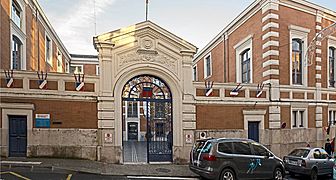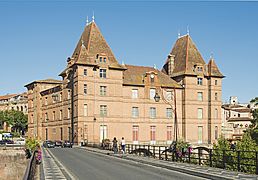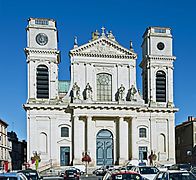Montauban facts for kids
Quick facts for kids
Montauban
|
||
|---|---|---|
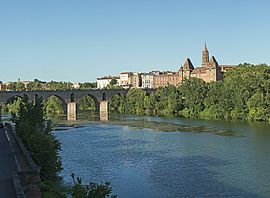
The Pont Vieux and the Ingres Museum
|
||
|
||
| Country | France | |
| Region | Occitanie | |
| Department | Tarn-et-Garonne | |
| Arrondissement | Montauban | |
| Canton | Chief town of 3 cantons | |
| Intercommunality | Pays de Montauban et des Trois Rivières | |
| Area
1
|
135.17 km2 (52.19 sq mi) | |
| Population
(2013)
|
57,921 | |
| • Density | 428.505/km2 (1,109.82/sq mi) | |
| Demonym(s) | Montalbanais | |
| Time zone | UTC+01:00 (CET) | |
| • Summer (DST) | UTC+02:00 (CEST) | |
| INSEE/Postal code |
82121 /82000
|
|
| Elevation | 72–207 m (236–679 ft) (avg. 140 m or 460 ft) |
|
| Website | www.montauban.com | |
| 1 French Land Register data, which excludes lakes, ponds, glaciers > 1 km2 (0.386 sq mi or 247 acres) and river estuaries. | ||
Montauban (Occitan: Montalban) is a city in southern France. It is located in the Tarn-et-Garonne area, which is called a department. Montauban is the main city, or préfecture, of this department.
The city is famous for its buildings made from reddish bricks. It sits on the right side of the Tarn river. Another river, the Tescou, joins the Tarn right here. Montauban was one of the first "bastides," which are special towns built with walls for defense.
Contents
History of Montauban
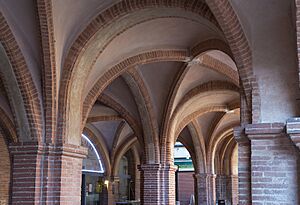
Montauban is one of the oldest walled towns in southern France. It was founded in 1144 by Alphonse Jourdain, who was the Count of Toulouse. Many people moved here from a nearby village called Montauriol.
In the 1200s, the town faced tough times. It suffered during the Albigensian Crusade, a religious war. It also faced problems from the Inquisition, a group that investigated people's beliefs. But by 1317, the town had recovered. The Pope chose Montauban to be the center of a new church area called a diocese. The old church of St Théodard became the main church, or cathedral.
In 1360, Montauban was given to the English by a treaty. However, the people of Montauban kicked them out in 1414. Later, in 1560, the city became a center for Protestants. Ten years later, it became one of four strongholds for the Huguenots (French Protestants). It even acted like a small independent country for a while.
In 1790, Montauban was part of the Lot department. It was the capital of a smaller area called a district. Later, in 1800, it became a sous-préfecture, which is like a smaller capital. In 1809, Napoleon created the Tarn-et-Garonne department. Montauban then became the main capital, or préfecture, of this new department.
Geography and Location
Montauban is about 50 kilometers (31 miles) north of Toulouse. It is located where the Tescou and Tarn rivers meet. The city is also about 80 kilometers (50 miles) from Agen. It is 76 kilometers (47 miles) from Albi and about 60 kilometers (37 miles) from Cahors.
The city covers an area of 135.17 square kilometers (52.19 square miles). Its average height above sea level is 140 meters (459 feet). At the city hall, the height is 103 meters (338 feet).
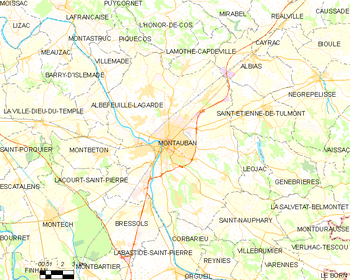 |
Montauban is surrounded by several other towns. These include Villemade, Piquecos, Lamothe-Capdeville, Albias, Saint-Étienne-de-Tulmont, Léojac, Saint-Nauphary, Corbarieu, Bressols, Lacourt-Saint-Pierre, Montbeton, and Albefeuille-Lagarde.
 |
Villemade | Piquecos and Lamothe-Capdeville | Albias |  |
| Lacourt-Saint-Pierre, Montbeton and Albefeuille-Lagarde | Saint-Étienne-de-Tulmont and Léojac | |||
| Bressols | Corbarieu | Saint-Nauphary |
Montauban's Climate
Montauban has an oceanic climate with mild summers. This type of climate is known as Cfb in the Köppen climate classification system.
The city gets about 708.7 millimeters (27.9 inches) of rain each year. October is usually the wettest month, with about 71.1 millimeters (2.8 inches) of rain. February is the driest month, with around 48.3 millimeters (1.9 inches) of rain.
The average temperature in Montauban for the whole year is 13.6°C (56.5°F). July is the warmest month, with an average temperature of 22.3°C (72.1°F). January is the coolest month, with an average temperature of 5.6°C (42.1°F).
| Climate data for Montauban, France | |||||||||||||
|---|---|---|---|---|---|---|---|---|---|---|---|---|---|
| Month | Jan | Feb | Mar | Apr | May | Jun | Jul | Aug | Sep | Oct | Nov | Dec | Year |
| Mean daily maximum °C (°F) | 9.2 (48.6) |
11.4 (52.5) |
15.1 (59.2) |
17.7 (63.9) |
21.8 (71.2) |
25.5 (77.9) |
28.3 (82.9) |
28.1 (82.6) |
24.8 (76.6) |
19.8 (67.6) |
13.1 (55.6) |
9.5 (49.1) |
18.7 (65.6) |
| Daily mean °C (°F) | 5.6 (42.1) |
6.8 (44.2) |
9.8 (49.6) |
12.3 (54.1) |
16.3 (61.3) |
19.8 (67.6) |
22.3 (72.1) |
22 (72) |
18.7 (65.7) |
14.7 (58.5) |
9.2 (48.6) |
6.1 (43.0) |
13.6 (56.6) |
| Mean daily minimum °C (°F) | 1.9 (35.4) |
2.2 (36.0) |
4.5 (40.1) |
6.9 (44.4) |
10.7 (51.3) |
14.1 (57.4) |
16.2 (61.2) |
15.9 (60.6) |
12.6 (54.7) |
9.6 (49.3) |
5.3 (41.5) |
2.6 (36.7) |
8.5 (47.4) |
| Average rainfall mm (inches) | 56.4 (2.22) |
47.7 (1.88) |
49.1 (1.93) |
55.9 (2.20) |
69.8 (2.75) |
61.4 (2.42) |
53.9 (2.12) |
59.4 (2.34) |
61.2 (2.41) |
70.8 (2.79) |
61.1 (2.41) |
61.2 (2.41) |
707.9 (27.88) |
| Source: Weatherbase.com [1] | |||||||||||||
Population of Montauban
Montauban has a population of 57,921 people. This means there are about 428 people living in each square kilometer (1,109 people per square mile).
People who live in Montauban are called Montalbanais in French.
City Administration
Montauban has been the main city, or préfecture, of the Tarn-et-Garonne department since 1809. It is also the capital of three smaller areas called cantons. These cantons are:
- Montauban-1
- Montauban-2
- Montauban-3
Interesting Places to Visit
Montauban has many cool places to see:
- The Place Nationale (National Square) is a beautiful square built in the 1600s.
- The Notre-Dame de l'Assomption cathedral is special because it's made of stone. Most buildings in Montauban are made of red bricks. King Louis XIV ordered it to be built.
- The Musée Ingres (Ingres Museum) used to be the old city hall and the home of the bishops. It was built in 1664. Today, it shows amazing paintings by the famous artist Jean Auguste Dominique Ingres. It also has sculptures by Antoine Bourdelle. Both artists were born in Montauban!
- The church of Saint Jacques is the only church in Montauban that is still completely from the medieval times.
- The Pont Vieux (Old Bridge) is a bridge built in the 1300s. It crosses the Tarn river.
Gallery
Famous People from Montauban
- Jean Auguste Dominique Ingres (1780-1867): A very famous painter.
- Antoine Bourdelle (1861-1929): A well-known sculptor.
Sister Cities
Montauban has special connections with other cities around the world. These are called "sister cities":
 Pawhuska, United States
Pawhuska, United States Yokneam, Israel
Yokneam, Israel Khemisset, Morocco
Khemisset, Morocco Kozarac, Bosnia and Herzegovina
Kozarac, Bosnia and Herzegovina
Related pages
Images for kids
See also
 In Spanish: Montauban para niños
In Spanish: Montauban para niños



